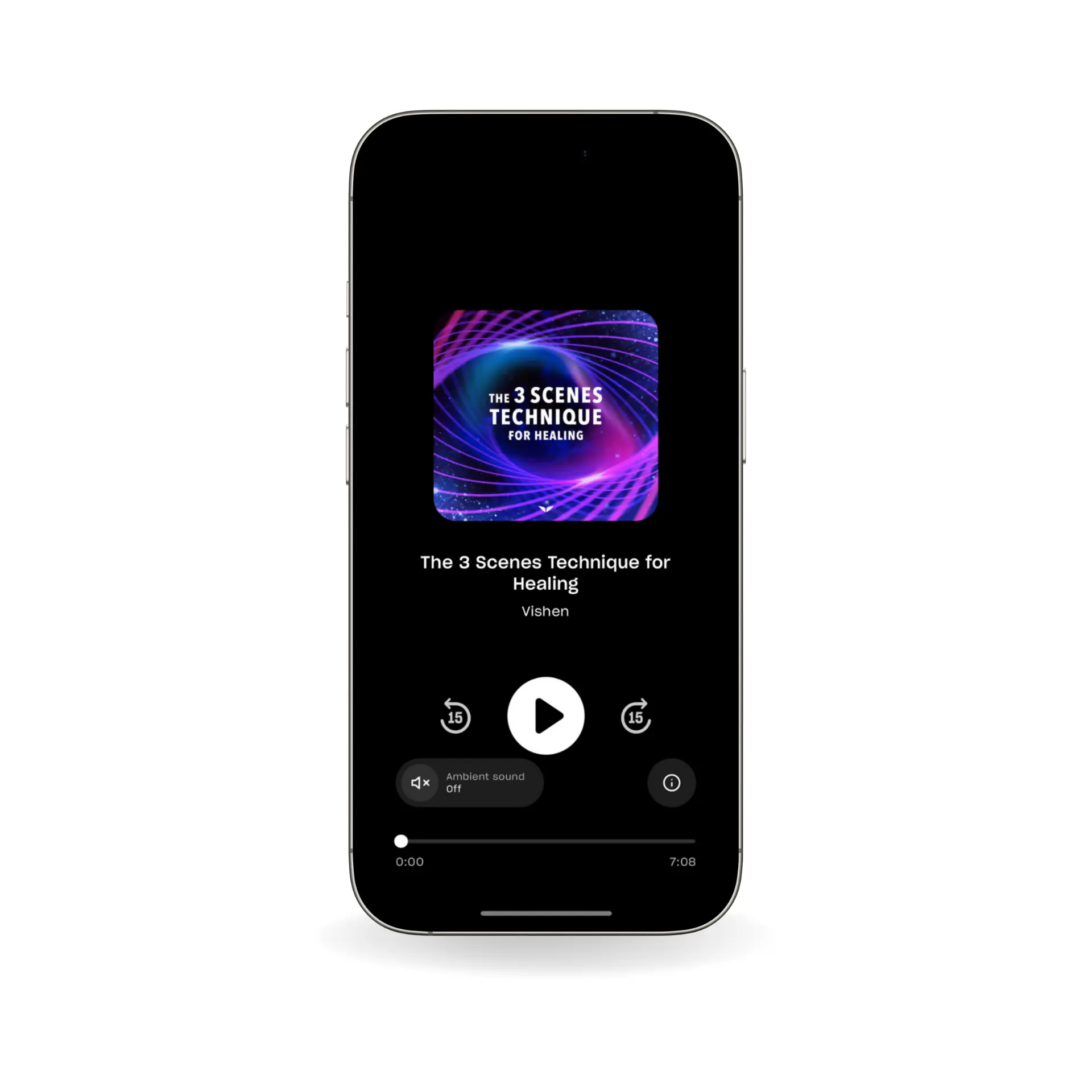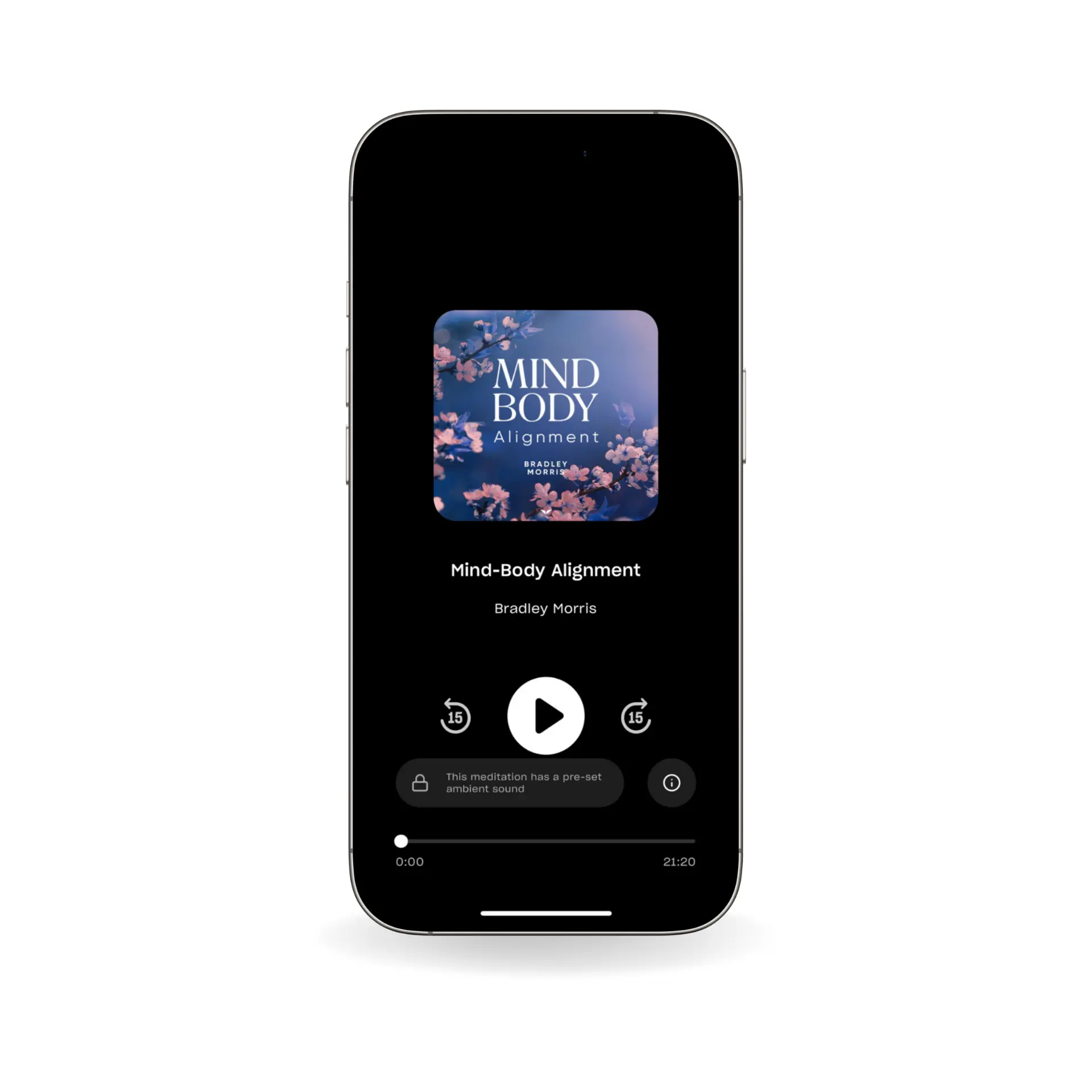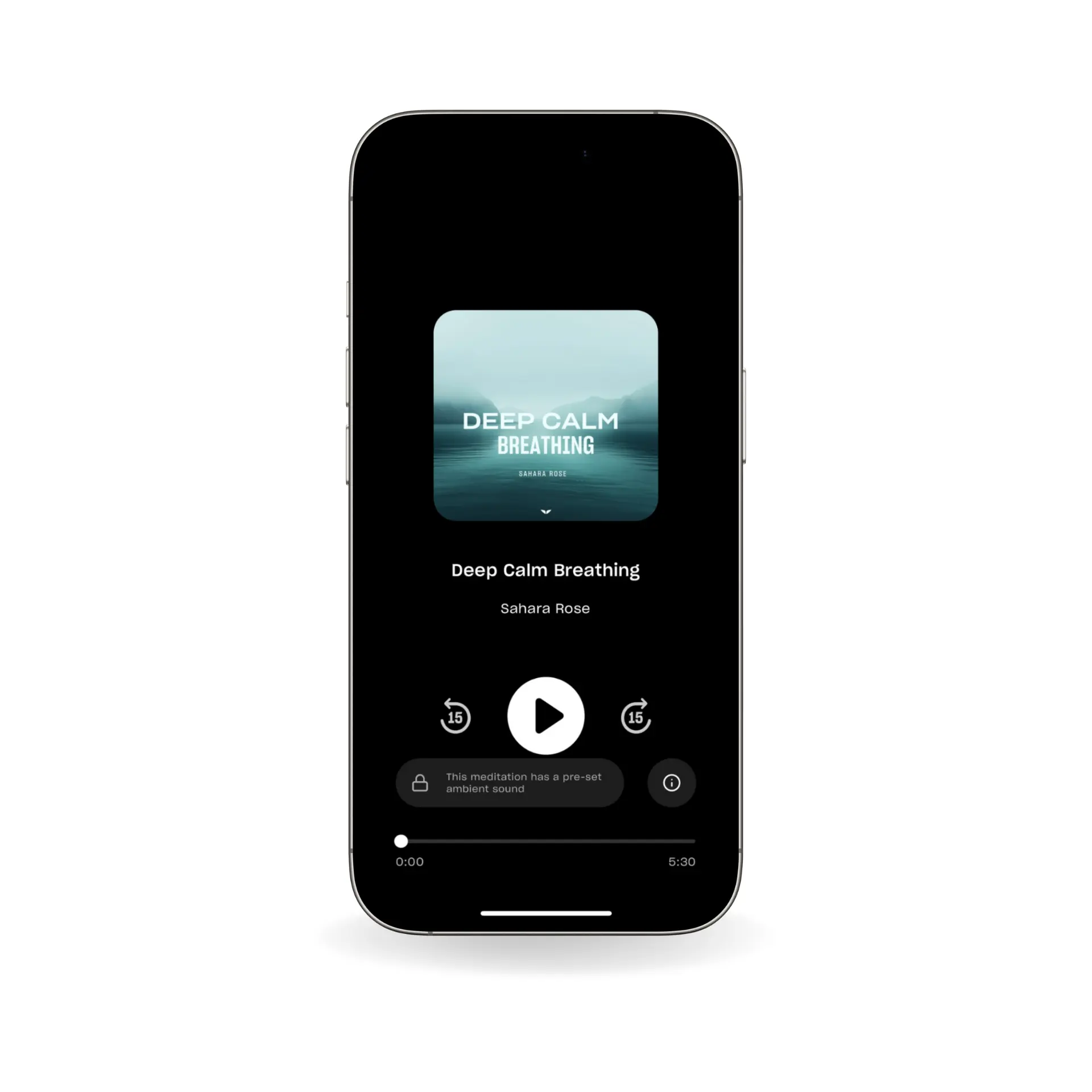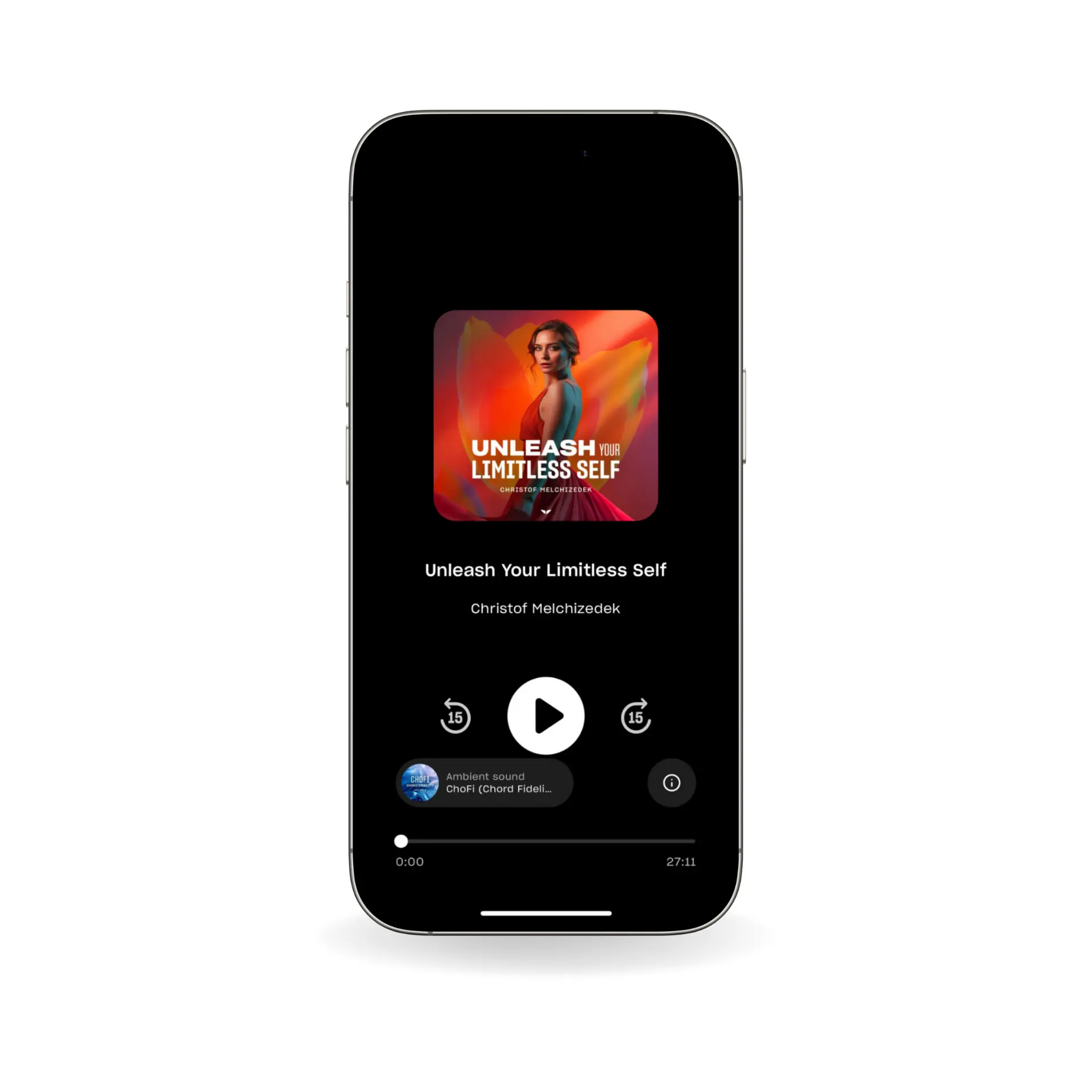When meditation hits easy, your body softens, thoughts slow, and time stretches, as if on command. But on other days? It’s a wrestling match with your own mind.
The back-and-forth is normal, and mastering balance between the two states is the essence of deep meditation.
According to Vishen, the founder and CEO of Mindvalley, it’s not about emptying the mind. On the contrary, it happens when “thoughts rearrange themselves effortlessly, where insight feels like a download instead of a struggle.”
Think of this practice as strength training. The first few sessions feel shaky—your muscles resist, and progress seems slow. But the more you train, the more natural it becomes. Resistance fades; effort turns into flow.
Deep meditation works the same way. At first, it feels like work. But once you find your rhythm, it stops being something you do and naturally becomes part of your mindfulness.
What is deep meditation?
Deep meditation helps you transcend ordinary awareness and learn how to reprogram your subconscious mind to connect to something beyond your daily thoughts.
As opposed to regular meditation, where your main goal is to stay in the now by focusing on your breath or an image, this is one of those meditation techniques where you can access a state where your mind stops racing and starts revealing insights buried beneath distraction.
Patterns emerge, problems unravel, and ideas form—not through effort, but as if they’ve been “waiting” for you to notice.
“You don’t have to force insight in deep meditation,” explains Vishen in The Silva Ultramind System program on Mindvalley, which is based on The Silva Method by the late mind science pioneer José Silva. “It arrives. Like an email you didn’t know was coming, but turns out to be exactly what you needed.”
The different brain waves you need to know
If regular meditation is dipping your toes in the water, then deep meditation is about diving straight in.
Here, the mind moves through four distinct brainwave states below, shifting from everyday awareness into a state where intuition sharpens, mental clutter dissolves, and transformation happens beneath the surface:
| Brain wave | Frequency range | Associated state | Role in deep meditation |
| Beta (13-20 Hz) | Waking consciousness | Active thinking, problem-solving, stress response | 1. Useful for focus but prone to overthinking 2. Deep meditation helps slow this down |
| Alpha (8-12 Hz) | Light relaxation | Creative flow, calm awareness, beginning of deep meditation | 1. The “gateway” to the meditative state—relaxed but alert 2. Where intuition and creativity kick in |
| Theta (4-7 Hz) | Deep relaxation | Dreamlike imagery, intuition, subconscious programming | 1. Where memories, insights are revealed 2. Where healing starts taking place 3. Deep meditation enables access to the theta waves consciously |
| Delta (0.5-3 Hz) | Deep sleep and healing | Restorative sleep, subconscious reprogramming, altered states | 1. The slowest brain wave 2. Where physical and emotional self-healing is activated 3. Consciousness gets expanded here (some advanced meditators access this while awake) |
| Gamma (30-100 Hz) | Peak consciousness | Heightened perception, deep focus, mystical experiences | 1. The highest frequency 2. Linked to elevated awareness, spiritual insights, and a deep sense of unity 3. Gamma brain waves can be experienced in advanced meditation and flow states |
The depth of your meditation has nothing to do with how long you can sit like a statue. It’s all about how smoothly you guide your brain into these slower, more powerful frequencies.
With the right approach, slipping into them can feel as natural as drifting off to sleep—effortless, seamless, and quicker than you’d think.
5 science-backed deep meditation benefits
Science is catching up to what ancient practitioners have long known: going deep within isn’t just a state of mind; it’s the path to radical transformation.
Meditation doesn’t just help you feel good. It can literally reprogram your mind and body at the deepest levels.
— Vishen, Mindvalley founder and CEO, and trainer of The Silva Ultramind System program
Here’s what happens when you up your deep meditation ante:
1. Your brain becomes a supermachine
Ever notice how your best ideas often come when your mind is at ease? That’s no coincidence.
Dr. Richard Davidson, a neuroscientist, professor, and founder of the Center for Healthy Minds, once described this process: “Our brain is continuously being shaped—we can take more responsibility for our own brain by cultivating positive influences.”
And he’s right. Deep relaxation meditation has been shown to “grow” your brain’s cognitive function. Yep, think better memorization, problem-solving, and creative thinking.
The science behind this? Studies by Harvard Medical School found that long-term meditators have increased cortical thickness in areas linked to attention and processing speed. Translation? Your brain literally upgrades itself when you get good at being “zen.”
Understanding this, Vishen explains, “When you train the mind to focus at deeper levels, you strengthen the same neural pathways that drive creativity, insight, and innovation.”
Take it from Udana Power, a multi-hyphenated creative based in Los Angeles. The Mindvalley member credits deep meditation sessions from The Silva Ultramind System for helping her “get authentic answers on what direction to take” whenever she faced a crossroads in life. She can now see “the underlying truth” of any situation.
2. Compassion becomes second nature
It’s easy to think of meditation as a solo journey. But the thing is, deep meditation can widen your emotional bandwidth. And when this happens, your connection with other people just gets better and better.
The proof is in the pudding: The practice increases activity in the anterior cingulate cortex and medial prefrontal cortex—areas linked to empathy and compassion.
Imagine:
- Not taking things so personally.
- Responding to conflict with clarity instead of your walls always up.
- Making people feel truly seen and understood—and feeling the same.
These are all the awesome social experiences you’ll have when you unlock the deep well of emotional intelligence already in you.
3. You become more emotionally bulletproof
It’s not real life if it doesn’t throw you curveballs now and then. But with deep meditation, you get to develop the mental space to respond with clarity and control, instead of being reactive all the time.
And here’s why: Consistent meditation has been proven to reduce the size of the amygdala, your brain’s fear center, while strengthening your prefrontal cortex so you can think more rationally and regulate your emotions.
So, what does this mean for you?
- Less “panic mode” and freakouts.
- A stronger grip on your day-to-day moods to lessen the nagging self-doubt, and
- A newfound ability to navigate moments of uncertainty in life, like a career transition, moving to a new city, or even dating after divorce.
Lifestyle coach Roger Schmidt, for one, knows firsthand what it’s like to be at the mercy of your emotions. His life once felt like a never-ending rollercoaster—swerving between uncertainty, self-doubt, and an endless search for direction. But deep meditation changed everything.
The biggest positive changes he’s noticed in himself? “Being less self-centered, more interested in other people, and being able to program myself effectively towards my goals,” he shares.
Roger’s story is proof that emotional resilience is mastering how you respond instead of suppressing what you feel. And deep meditation is the ultimate training ground.
4. Your mind unlocks higher-level awareness
The thing about deep meditation is, it expands your perception of reality itself. According to Vishen, it doesn’t just “help you feel good, it can literally reprogram your mind and body at the deepest levels.”
Because as nature would have it, the practice triggers high-amplitude gamma waves, the brain activity associated with profound insight, heightened intuition, and peak awareness.
Now, what happens IRL when your mind operates at this level?
- You live more purposefully, aligning with what truly matters to you in life instead of chasing external validation.
- Your intuition becomes your best friend. And so, decision-making becomes more effortless and precise, as if your inner compass is always on point.
- You feel more alive in the present moment. Everything seems more colorful and vibrant around you, interactions feel more in-depth and meaningful, and your day-to-day or week-to-week progress—at home or in the workplace—becomes more tangible.
“The more time you spend in deep meditation, the more you access what José Silva called the ‘ultramind state’—a level where intuition sharpens, synchronicities increase, and life seems to unfold effortlessly,” Vishen adds.
5. Your body gets great at healing itself
Turns out, theta and delta brain waves is responsible for your ultimate glow-up.
And meditation gets you tapping into these frequencies, starts triggering the body’s natural repair mechanisms, and helps you heal from the inside out. Research shows that these deep meditative states lower stress levels, reducing inflammation and strengthening immune function.
“When you train your mind to access deeper states, your body follows,” says Vishen. “It shifts into repair mode, reducing stress hormones and activating healing at the cellular level.”
And as if that’s not already amazing, deep meditation also helps you age better by improving cell regeneration and slowing down biological aging. For real: long-term deep meditators were found to have longer telomeres—that is, the protective caps on your DNA responsible for longevity and cellular health.
Perhaps it’s no coincidence the Dalai Lama looks younger than some celebrities with a glam squad.
5 deep meditation techniques for self-mastery
You may be wondering, ‘Why are there so many deep meditation techniques out there?”
Simple—every mind is different. Some people need more structure to drop into the blissful frequencies, while others do better with effortless immersion. The key to mastering this approach? Finding the right technique that meets you where you are.
Not sure which to start with? You can start exploring with any of the following five:
1. Samatha meditation
If your thoughts are all over the place and you find yourself mindlessly scrolling on the phone, hit pause and consider the Samatha meditation.
Rooted in ancient Buddhist traditions, this technique trains your focus to be unshakable, helping you enter deep states of calm and concentration.
How it works:
- Pick one point of focus—your breath, a candle flame, or even a mantra.
- Each time your mind wanders (and it will), gently bring it back to your focus.
- Over time, your brain builds the neural circuits for intense focus and deep stillness.
Why it’s great: The longer you hold focus, the deeper you sink into meditation. Your thoughts slow down, and your awareness sharpens, creating the perfect foundation for deeper states of consciousness.
2. Vipassana meditation
Is overthinking keeping you up at night? Have you spent too much time replaying conversations in your head? Then Vipassana meditation might be exactly what you need.
This Buddhism-based practice teaches you to observe thoughts without reacting to them. So instead of being trapped in a loop of worry, you gain mental clarity and emotional balance.
How it works:
- Find a quiet space and sit comfortably.
- Observe your breath, bodily sensations, and passing thoughts—without trying to change or control them.
- When emotions arise, acknowledge them, but let them pass like clouds in the sky.
Why it’s great: Vipassana helps you detach from negative thought patterns and develop a clear, steady mind. Over time, you become less reactive and more grounded, even when life throws you curveballs.
3. Transcendental meditation
Popularized by Maharishi Mahesh Yogi (whose students include The Beatles), transcendental meditation—or TM for short—helps you access deep, restful states effortlessly without needing to battle your thoughts.
If traditional meditation techniques feel like work, the right TM approach trains you to float into deep meditation on autopilot.
How it works:
- Sit comfortably with eyes closed.
- Silently repeat a personalized mantra, preferably vetted by a certified TM teacher.
- Let your mind naturally sink into deep relaxation without forcing anything.
Why it’s great: TM allows you to bypass surface-level distractions and fast-track into deep meditation. It’s perfect for those who struggle with overactive minds.
4. The Silva Ultramind guided meditation
Created by José and narrated by Vishen himself, this meditation helps you enhance creativity, reprogram limiting beliefs, and unlock higher cognitive abilities all in one.
Instead of passively observing thoughts like how you would with other techniques, here you engage directly with your subconscious to create real-world shifts.
How it works:
- Consciously enter the alpha and theta states to activate your heightened level of awareness.
- Apply specific visualization techniques to solve problems, improve mental clarity, and strengthen intuition.
- Train your mind daily to access these deeper states on command over time, even outside of meditation.
Try a full guided session by Vishen below to understand what it’s really about:
Why it’s great: This iconic technique sharpens how you see the world. The more you practice it, the more life seems to “click”—you start recognizing opportunities everywhere and the subtle cues that guide you toward the right choices in life.
5. Non-sleep deep rest
Whenever you’re too exhausted to meditate yet too wired to fall asleep, the non-sleep deep rest—or NSDR—approach can be a compelling alternative to try. It’s an umbrella term that encompasses various practices, from yoga nidra to script-based NSDR hypnosis.
Developed by Dr. Andrew Huberman, this modern technique induces deep sleep-like relaxation that deep meditation offers. And it’s also great if you’ve been trying to up your pre-sleep relaxation game but have been struggling with deep sleep meditation or wondering how to meditate in bed effectively.
How it works:
- Get comfortable by lying down on a yoga mat, recliner, or in bed.
- Follow a guided NSDR session that incorporates slow, deep breathing meditation, progressive relaxation, and body scanning.
- Let your brain shift into theta and delta states, mimicking the effects of deep sleep while keeping you semi-conscious.
- Emerge refreshed without the grogginess of an actual nap.
Why it’s great: If you’re running on fumes but don’t have time for a nap, NSDR can reset your brain in just 20 minutes—no grogginess included. And if you struggle with deep sleep meditation, this technique trains your nervous system to slow down, making it easier to drift off naturally.
How to get into deep meditation in 5 steps
Maybe you can tell a Samatha meditation from a Silva Ultramind session. You might even know which ones call to you on different days—like an intuitive playlist for your mind.
But here’s the thing: No matter which technique you choose, slipping into deep meditation follows the same baseline process. Think of it as the pre-game ritual before your mind takes center stage.
Here’s how to set yourself up for that deep, uninterrupted dive inward:
1. Set up your meditation space
Your brain thrives on cues and associations.
Ever noticed how stepping into a gym instantly shifts your mindset into “workout mode”? The same applies to meditation. A designated space tells your mind: It’s time to go inward.
Here’s how to create your go-to meditation nook:
- Choose a quiet spot where you won’t be disturbed. Bonus points if you add soft lighting or a relaxing scent (from a candle or a diffused essential oil).
- Use comfortable seating, whether that’s a meditation cushion, a chair, or even lying down (just remember not to doze off).
- Reduce sensory distractions as much as you can with noise-canceling headphones, an eye mask, or gentle background music. Put your phone on silent or airplane mode.
Remember, your mind’s not going to drop in deep if your space looks like a crime scene. Set it up like a VIP lounge for your consciousness.
2. Get your body to relax
Before diving deep into your practice, you need to signal your nervous system that it’s safe to relax. This means switching from a high-strung, stressed-out state (sympathetic mode) to a calm, restorative state (parasympathetic mode) in three steps:
- Turn to deep breathing meditation. Nothing like mindful breathing to lower your heart rate and cortisol (stress hormone) level.
- Engage all of your senses. Make yourself some herbal tea to sip, stretch gently, or take a warm shower to melt tension.
- Practice progressive relaxation. Start from your toes and mentally “switch off” each body part until you feel weightless. Pro-tip: Try the Centering Exercise, an integral component of The Silva Ultramind System program, below:
3. Pick a technique that works for you
No two minds are the same, which is why different deep meditation techniques suit different people. Some thrive on structured guidance, while others prefer effortless immersion. The key? Find what feels intuitive to you.
Here’s how to choose based on what you need in the moment:
- When your mind is restless: The Samatha meditation can prime laser-sharp focus.
- If overthinking is your nemesis: Vipassana helps you detach from your mental noise.
- If you want to meditate with more ease: The stillness offered by TM is unparalleled.
- To get better with more structure: The Silva Ultramind System blends mental relaxation and goal-oriented steps.
- Whenever you need more rest: NSDR resets your body and mind like a power nap… without the actual shut-eye.
When the technique fits, meditation stops feeling like work and starts feeling like a power move.
4. Embrace the mental ebbs and flows
Stray thoughts will come and go. Some days, they’ll feel like an unstoppable flood. But the trick to dealing with them? Just let them be.
- Acknowledge distractions, then gently return to your anchor. Think of your thoughts as clouds passing in the sky. No need to chase or control them.
- Embrace the natural rhythms of your mind. Some sessions will feel effortless, others like a mental marathon. Both are part of the process.
- Avoid the trap of “trying” to meditate. The harder you push, the more elusive stillness becomes. So, let go and trust the descent.
Control is overrated; surrender is where the magic happens. The more you lean into the process, the deeper into stillness you drop.
5. Transition in and out of meditation mindfully
Coming out of deep meditation is just as important as entering it. If you snap back too fast, you risk jolting your nervous system and undoing the calm you just cultivated.
Instead, ease back into the present moment with intention—with these methods:
- Gently bring movement back into your body. Wiggle your fingers and toes, and stretch lightly.
- Open your eyes slowly. Give yourself a moment to fully return before engaging with the world.
- Reflect on the experience. What do you see in meditation usually? What sensations, insights, or shifts would you notice at the end of every session? Jot your thoughts down, so you can look back and observe your thinking patterns.
Ultimately, the true impact of deep meditation is seen in how it transforms the way you navigate life, well beyond moments of stillness.
BONUS: 5 guided deep meditations to try today
If you want to cut the guesswork and dive straight into the good stuff, guided deep meditations are your fast pass.
These sessions, led by some of the world’s best meditation experts, are available on the Mindvalley app. They give you the perfect mix of pacing, technique, and next-level guidance.
Whether you’re just starting out or ready to take things deeper, consider them your VIP pass to a sharper, calmer, and more dialed-in mind.
1. The 3 Scenes Technique for Healing with Vishen
This guided journey is one of the few signature ones in The Silva Ultramind System program.
Here Vishen helps you:
- Tune into your subconscious to detect health issues before they manifest
- Course-correct them before they take root.
- Use visualization to see yourself or a loved one in the pink of health
With his guidance, you’ll eventually see that accept that everything is energy, and from there, reprogram your mind to focus on healing and restoration.

2. Mind-Body Alignment with Bradley Morris
Your body holds more wisdom than you think—it knows where energy is blocked, where tension lingers, and where healing is needed. This deep meditation helps you tap into that wisdom.
Through a body awareness process, you’ll be guided to dissolve stuck energy, bring love to the areas of your body that need it most, and cultivate an unshakable sense of connection with yourself. The result? More freedom, flow, and well-being than ever before.

3. Deep Calm Breathing by Sahara Rose
When stress hijacks your day, the quickest way back to balance is through your breath.
This guided practice walks you through deep breathing meditation techniques designed to melt tension and bring you back to the present moment. With every inhale, you’ll invite tranquility. And through every exhale, you’ll release what no longer serves you.

4. Unleash Your Limitless Self by Christof Melchizedek
You can’t step into your highest potential while still carrying the weight of your past, which is why this guided meditation invites you to let it all go.
Expect to release old fears, self-imposed limits, and emotional blocks in this session. As you clear away what’s holding you back, you’ll align with your highest path and open the doors to success, freedom, and a life without limits.

5. Entering Flow by Sonia Choquette
This guided meditation cuts through the noise, helping you find your inner rhythm again—even when your mind won’t stop spiraling.
Designed to clear overthinking and mental clutter, intuition expert and healer Sonia puts you in touch with your gut, allowing you to move through life with a stronger sense of knowing. The more you surrender to flow, the more effortlessly things seem to fall into place.

Frequently asked questions
What does deep meditation feel like?
Simply put, it can feel like slipping into a lucid dream without falling asleep. Your thoughts slow down, but your awareness sharpens.
Some people may feel weightless as if floating in stillness. Others describe it as stepping into an infinite space where clarity comes without effort.
Scientifically, this happens because your brain shifts into theta and delta waves during such an experience. Remember, it’s the same states linked to creativity, intuition, and deep healing.
When in doubt, just remember Vishen’s description of it: “The usual noise of everyday life fades, and in its place, a quiet intelligence emerges.”
Is deep meditation dangerous?
This short answer is… no.
And here’s why: your brain naturally cycles through deep meditative states every day. Right before sleep, in a flow state (when you’re hyperfocused on a task), or when you zone out in the shower and suddenly get a genius idea.
So, it’s a normal phenomenon that deep meditation happens to tap into.
That said, if you’re dealing with a lot of bottled-up emotions, meditation can bring them up to the surface. Not all sessions are blissful, and rightfully so.
You’re not supposed to suppress what comes up; you let it pass through, so it doesn’t run the show in your subconscious anymore. “Imagine feeling deeply rested yet completely awake—like your mind has been washed clean of clutter,” Vishen shares.
What do you see in deep meditation?
According to Vishen, your imagination—the very thing activated by the mental screen technique in The Silva Ultramind System—is how you get to know yourself. “It’s where you receive and project information from beyond your conscious mind,” he adds.
The swirl of colors, geometric patterns, old memories, or even new images you see? Those are insights into your life. Think of them as scenes from a movie about you, through which guidance from your higher self can emerge.
So, take note of the visuals and symbols that appear when you meditate; they’re trying to tell you something. Journaling your experiences can help you track patterns and piece together the bigger picture.
But what if you see nothing at all? That’s fine, too. Because the thing is, deep meditation is not just about what you see, it’s also about what you feel. Clarity, peace, or even an emotional release—these are equally powerful “fuel” for your self-mastery journey.
How long does it take to get into deep meditation?
It depends. Some people drop in within minutes, while others need a little more time. The biggest factor? Consistency. The more you meditate, the faster your mind learns to switch gears and sink into deeper states.
Experienced meditators tend to slip into deep meditation more quickly—not because they have superhuman focus, but because they’ve trained their brains to recognize the shift.
Of course, there’s the fact that not all techniques work at the same pace. For example:
- NSDR can get you there fast—within 20 minutes or less—because it mimics deep sleep states.
- TM leverages mantras to help you ease into relaxation effortlessly, so it’s also quicker than other techniques.
- The Silva Ultramind guided meditation takes practice; to get the best results, you’d have to do it multiple times a day, for minutes at a time. But once mastered, it allows you to tap into deeper levels of intuition, visualization, and problem-solving.
Ultimately, how fast you reap the rewards of deep meditation depends on your “why.” If your goal is quick relaxation, breathwork-based techniques might work best.
But if you’re in it for deeper intuition and subconscious reprogramming? Know that the journey takes a bit longer—but it’s absolutely worth it.
Find your spiritual superpower
Imagine moving through life with a mind that’s razor-sharp, an intuition so dialed in it feels like a superpower, and a baseline level of calmness so unshakable that no amount of chaos can rattle you. See, that’s the real flex of deep meditation.
And when you’re ready to hone in on it, Vishen’s free masterclass, Access Altered States of Mind, is where you can start—it’s a prelude to The Silva Ultramind System program on Mindvalley.
By signing up for the session, you’ll learn to unlock deeper states of consciousness, sharpen your intuition, and train your mind to solve problems the way top visionaries do.
Your greatest insights, your biggest breakthroughs… they’re waiting for you in the deeper layers of your mind. And all you have to do is to take the plunge.
Welcome in.









